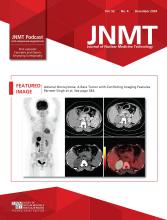Visual Abstract
Abstract
It has been some time since the Journal of Nuclear Medicine and Technology has published an article on best practices in amyloid imaging. In light of the recent Food and Drug Administration approval of new antiamyloid therapies (AATs) to decrease amyloid plaques in the brain and slow progression of mild cognitive impairment, and the potential increase in the number of amyloid PET scans being acquired to document amyloid plaques, the Journal of Nuclear Medicine and Technology felt it was a perfect time to publish a refresher on best practices. AATs are administered to help slow progression of mild cognitive impairment, allowing patients to live independently a little longer before having to give up their independence and move in with family or into an assisted living facility. Neurologists prescribing AATs must first document that the patient has amyloid plaques. To do this, amyloid PET can be performed, or a lumbar puncture can be used to look for amyloid plaques in the cerebrospinal fluid. Although the latter is more cost-effective and has no associated radiation exposure, it is highly invasive compared with amyloid PET. High-quality amyloid PET scans interpretated by a trained nuclear medicine physician are the first step and key to providing the dementia expert and patient with accurate information on amyloid status, allowing for the best decisions on patient management.
Footnotes
CE credit: For CE credit, you can access the test for this article, as well as additional JNMT CE tests, online at https://www.snmmilearningcenter.org. Complete the test online no later than December 2027. Your online test will be scored immediately. You may make 3 attempts to pass the test and must answer 80% of the questions correctly to receive 2.0 CEH (Continuing Education Hour) credit. SNMMI members will have their CEH credit added to their VOICE transcript automatically; nonmembers will be able to print out a CE certificate upon successfully completing the test. The online test is free to SNMMI members; nonmembers must pay $15.00 by credit card when logging onto the website to take the test.
Published online Nov. 12, 2024.








